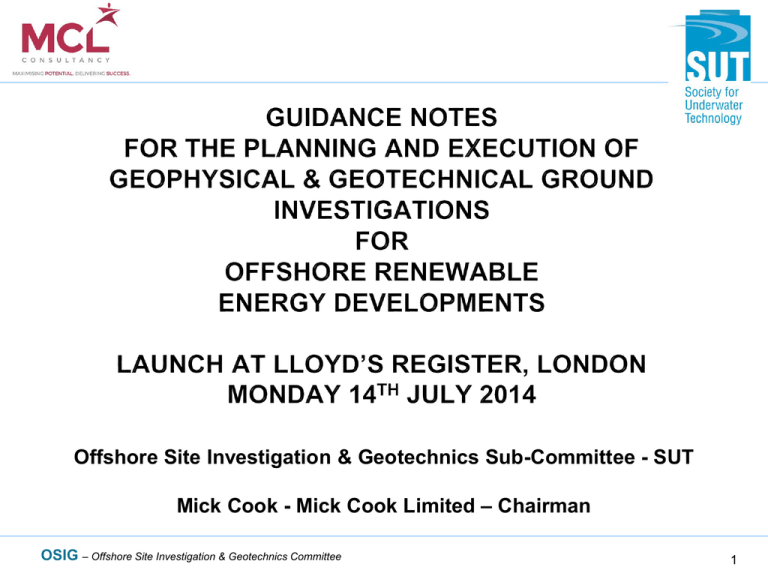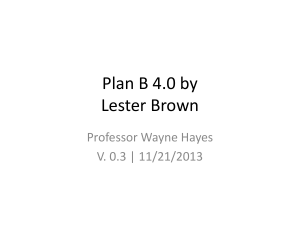OSIG
advertisement

Offshore Site Investigation & Geotechnics Sub-Committee - SUT Mick Cook - Mick Cook Limited – Chairman OSIG – Offshore Site Investigation & Geotechnics Committee 1 Guidance Notes - Chronology Originally commenced 2005 Re-commenced Sept’ 2011 1st draft issued for review Aug’ 2012 Review meeting at TCE Sept’ 2012 Feedback incorporated and document re-structured Draft 2 issued for comment April 2013 Feedback incorporated Document finalised and prepared for printing May 2014 Launch July 14th 2014 OSIG – Offshore Site Investigation & Geotechnics Committee 2 OSIG Renewables Guidance Notes Sub-committee NAME COMPANY Andy Barwise* 1 Gardline Will Cleverley* 1 OWC Mick Cook* 2 Independent Consultant Ray Hobbs* 1 Independent Consultant Tony Hodgson* 1 Fugro Leo James 2 RPS Energy Chris Jenner 3 Mainstream Neil Morgan* 1 Lloyds Register Alastair Muir Wood *1 DONG Richard Orren* 2 Senergy Julian Osborne* 1 Vattenfall Rupert Rowland* 1 Subsea 7 Charles Wark 1 RWE * = OSIG committee member, 1 = Geotech Eng, 2= Geophysicist, 3 = Environmental Scientist OSIG – Offshore Site Investigation & Geotechnics Committee 3 Why do we need Guidance Notes? Offshore renewables present new challenges Offshore SI is a specialist area requiring specialist input Why are these issues important? – Foundations: ~25-40% of CAPEX – Cables: ~80% of insurance claims in offshore wind Mitigate safety, environmental & commercial risk OSIG – Offshore Site Investigation & Geotechnics Committee 4 Examples of offshore renewable sites •Wind turbine generator sites • Hydrokinetic device sites •Substation platform sites •Cable routes OSIG – Offshore Site Investigation & Geotechnics Committee 5 Oil & Gas vs Renewables- a question of scale (?) OSIG – Offshore Site Investigation & Geotechnics Committee 6 High energy…difficult sites OSIG – Offshore Site Investigation & Geotechnics Committee 7 Guidance Notes: Objectives To provide non-specialists with information on issues to be considered and practices to be adopted To provide a framework for specialists To aid survey planning & execution To mitigate safety, environmental and commercial risks inherent in any offshore project OSIG – Offshore Site Investigation & Geotechnics Committee 8 Guidance Notes: Guiding Principles To aid cost-effective, fit-for-purpose offshore site investigation (geotechnics and geophysics) Sufficiently generic to cover most offshore renewables developments International Reference to existing guidelines Solely marine/offshore Include in-field and export power cables Learn from previous guidelines Best practice OSIG – Offshore Site Investigation & Geotechnics Committee 9 OFFSHORE SITE INVESTIGATION AND GEOTECHNICS COMMITTEE GUIDANCE NOTES FOR THE PLANNING AND EXECUTION OF GEOPHYSICAL AND GEOTECHNICAL GROUND INVESTIGATIONS FOR OFFSHORE RENEWABLE ENERGY DEVELOPMENTS ( May 2014) OSIG – Offshore Site Investigation & Geotechnics Committee 10 Contents Introduction Part 1 - Planning – Managing geological and geotechnical risk – The ground model – Planning and offshore ground investigation Part 2 - Execution – – – – – General Geophysical investigation Geotechnical investigation Positioning Data integration, interpretation & reporting Glossary Appendices – References, Codes, Standards and Guidance Notes – Geohazards – Geotechnical testing methods OSIG – Offshore Site Investigation & Geotechnics Committee 11 2 Part structure – Planning & Execution Part 1 – Planning – this section presents a strategy that developers are recommended to follow in the planning of ground investigations and is aimed at practitioners with minimal experience of geophysical and geotechnical investigations. Part 2 – Execution – this section presents key aspects that should be considered when performing such ground investigations. It is aimed at readers actively involved in the day-to-day management and application of ground investigations and is designed as an aide-mémoire. OSIG – Offshore Site Investigation & Geotechnics Committee 12 Managing geological and geotechnical risk – Section 2 Central to project viability – – – – – – Costs Design Schedules Construction methodologies H&S Environmental issues Reference to Clayton (2001) – why are ground related risks so high Typical hazards OSIG – Offshore Site Investigation & Geotechnics Committee 13 Hazards and their impact – Appendix 2 Key features to be assessed by means of survey and geotechnical investigations Man-made features: • Pipelines: on or buried below the seabed • Communications cables • Wrecks, including ships aircraft & submarines • Wellheads and abandoned well locations • Unexploded ordnance (UXO) and related debris, previously deployed or dumped • Navigation or metocean buoys • Archaeological remains • Miscellaneous debris • Power and umbilical lines & cables • Waste, chemical or other dumping grounds • Jack-up rig footprints • Rock dumps • Scour protection material • Gravel extraction areas • Export and intra-array cables • Wind turbines, wave, tidal arrays • Manifolds and templates • Platforms: active, abandoned, or toppled • Anchorage Natural seabed features: • Seabed topography and relief • Seabed sediments • Sand: banks, waves, and mega- ripples • Glacial features including iceberg plough marks, flutes and moraines • Rock outcrops, pinnacles and boulders • Seabed channels and scours • Peat • Gravel beds • Hard grounds / cemented sands • Submerged forest or terrestrial palaeolandscape • Unstable or steep slopes • Gas vents and pockmarks • Collapse features • Fluid expulsion features • Chemosynthetic communities • Fault escarpments • Reefs • Mud: flows, gullies, volcanoes, lumps, lobes • Slumps • Diapiric structures • Gas hydrate mounds Subsurface geological features: • Sedimentary sequences • Stratigraphy • Buried infilled channels • Hard grounds / cemented sands or buried land surfaces • Gravel beds • Boulder beds • Rock head or igneous intrusion near seabed • Peat • Erosion and truncation surfaces • Shallow water flow zones / loose sands • Glacial features incl. drumlins, loess and moraines • Faults - tectonic or glacigenic • Shallow gas charged intervals • Gas chimneys • Salt or mud diapirs and diatremes • Buried slumps and mass transport complexes • Gas hydrate zones and hydrated soils Note: The order of significance is likely to depend on the area of the world and the previous experiences of specific environments; surveys are performed in order to identify what is present – other man made or geological hazards may be present that are not included on this list. A risk and impact assessment is required to determine whether a hazard present is a risk to development. OSIG – Offshore Site Investigation & Geotechnics Committee 14 The ground model – Section 3 Iterative and continuous process throughout life cycle Level of risk inversely proportional to level of knowledge What is a ground model Use of the ground model Development of the ground model Desk study Ground investigation programme OSIG – Offshore Site Investigation & Geotechnics Committee 15 A typical process of understanding ground conditions – Figure 1 OSIG – Offshore Site Investigation & Geotechnics Committee 16 Example ground investigation process flowchart for an offshore wind development – Figure 2 Analysis of Regional Geology Review the Developer’s Requirements Foundation Selection Shortlisting Undertake a Desk Study Prepare the Ground Model Database Input Data from Section 3.4 Other Surveys e.g. Metocean, Environmental, Archaeological, etc. Survey Planning & Risk Assessment Reconnaissance Ground Investigation & Testing Geophysical and Geotechnical Scope of Work Geohazard Assessment If required Factual & Interpretive Reports Integrated Interpretation & Evaluation Other Studies e.g. Foundation selection/construction, cabling Update the Ground Model Database Site Specific Data Survey Planning & Risk Assessment Detailed Ground Investigation & Testing Geophysical and Geotechnical Scope of Work OSIG – Offshore Site Investigation & Geotechnics Committee Factual & Interpretive Reports Update the Ground Model Database Geohazard Assessment Site Specific Data 17 Example timeline for an offshore wind farm project. Site investigation phase – Figure 3 OSIG – Offshore Site Investigation & Geotechnics Committee 18 Planning an offshore ground investigation – Section 4 Aims and objectives – End users/stakeholders – Design codes/national standards Type of investigation Scope of investigation – – – – – – Generator and sub-station foundations Installation and maintenance Inter-array cables Export cables Shore crossings Data collection structures OSIG – Offshore Site Investigation & Geotechnics Committee 19 Geophysical vs Geotechnical Benefits Limitations Geophysical Investigations Wide range of data acquired simultaneously from one vessel Large areal coverage in short time – efficiency Continuity between specific point locations Wide range of depth of sub-bottom investigation Remote sensing tool that requires ground truthing Qualitative results subject to interpretation Some systems very weather/noise sensitive Geotechnical Investigations Range of systems for different soils and applications Quantitative results used for engineering design Physical measurement of soil and rock properties Generally, less weather sensitive than geophysics OSIG – Offshore Site Investigation & Geotechnics Committee Single data point, may need many locations to investigate an area 'Slower' acquisition rates than geophysics 20 Part 2 – Execution, General – Section 5 HS&E Competent personnel Developer’s representatives Contractor and vessel/rig selection Data and information management – Geospatial data provision – Standards Offshore data processing, analysis and interpretation Developer/contractor liaison OSIG – Offshore Site Investigation & Geotechnics Committee 21 Geophysical investigation – Section 6 Reference to other guidance notes Equipment used, application, operational issues and constraints Sub-bottom profiling systems Time/depth conversion OSIG – Offshore Site Investigation & Geotechnics Committee 22 Schematic layout of geophysical equipment – Figure 4 Courtesy Osiris Projects OSIG – Offshore Site Investigation & Geotechnics Committee 23 Geotechnical investigation – Section 7 Scope of geotechnical works Advantages/disadvantages vessel/rig types – Table 4 Data coverage – example best practice geotechnical work scopes for different foundation types and construction vessels – Table 5 Geotechnical data requirements Types of sampling and in situ test data – Table 6 OSIG – Offshore Site Investigation & Geotechnics Committee 24 Structure and foundation types – Figure 5 OSIG – Offshore Site Investigation & Geotechnics Committee 25 Positioning – Section 8 Use of GPS Reference to existing guidance Tidal reduction In-water sensor positioning OSIG – Offshore Site Investigation & Geotechnics Committee 26 Data integration, interpretation and reporting – Section 9 Holistic approach Integration essential Co-ordination over prolonged periods of investigation Limitations Report deliverables OSIG – Offshore Site Investigation & Geotechnics Committee 27 Feedback/comments Reviewers Including British Geological Survey Certification Authorities/Warranty Surveyors Bureau Veritas, DnV, GL, Global Maritime, Intertek, Lloyds Register China Renewable Energy Engineering Institute Consultants Developers DONG, EDF, E.On, Forewind, GDF Suez, Iberdrola, Mainstream, Scottish Power, RES, SSE Renewables, Statoil, Vattenfall Engineering contractors/consultancies OSIG UK, USA, Australia (> 50 members) Installers RenewableUK Survey Contractors The Crown Estate Universities OSIG – Offshore Site Investigation & Geotechnics Committee 28 Acknowledgements and thank you RenewableUK The Crown Estate China Renewable Energy Engineering Institute OSIG OSIG sub-committee Lloyd’s Register OSIG – Offshore Site Investigation & Geotechnics Committee 29 Guidance Notes Free download from SUT web-site from Tuesday 15th July 2014: www.sut.org Hardcopies available £15 per copy from SUT. OSIG – Offshore Site Investigation & Geotechnics Committee 30 For more information contact: www.sut.org Or OSIG sub-committee Chairman OSIG – Offshore Site Investigation & Geotechnics Committee 31






